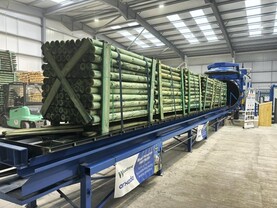The alternative to soon-to-be-banned creosote could drive up the price of timber stakes by €5 apiece, the Joint Oireachtas Committee on Agriculture heard on Wednesday 8 March.
From 30 April this year, creosote-treated timber stakes will be banned for use in farming by the EU.
“From what I’m hearing a stake, which is typically €10 now, it could soon be up to €15,” James Geoghegan, who imports and distributes creosote stakes, told the Oireachtas committee.
A new copper-oil-based treatment called Tanasote was approved by the Department of Agriculture in 2022, but it will be at least a year before Irish timber suppliers will be able to get their hands on any product.
“The lead time to upgrade new facilities with the infrastructure needed is very significant. We know, from planning and commissioning to end game, that there is a lead time of 18 months,” Richard O’Connor, business director of pressure treated timber company PDM said.
The company, based in Kill, Co Kildare, manufactures and treats timber utility posts for the telecommunications and power industries as well as agriculture.
A seven-year derogation for creosote use has been secured for railway sleepers and telephone poles, so this part of PDM’s business will remain.The Kildare timber supplier said that despite creosote being available through a derogation for the last 20 years, there was not enough warning from the Government when introducing the ban.
Service life
“The data we have so far is predominantly around the Tanosote product,” O’Connor said, “and there have been studies going on in the UK for probably four to five years.
“The company behind Tanasote, called Arxada, are saying that if properly treated, you should be able to get a service life of up to 40 years.”
However, O’Connor said that he has seen poles, particularly ESB poles, treated with creosote as much as 70 years ago, which still stand the test of time.
“I’m confident that the new copper oil products will get a reasonable service life; maybe not as good as creosote, but certainly significantly better than the water-based treatments that are available on the market right now, and in my experience, they are failing typically five and six years after service life,” he said.
Read more
Creosote alternative not there in quantity required to fulfil demand
Where to now for fence post preservation?
The alternative to soon-to-be-banned creosote could drive up the price of timber stakes by €5 apiece, the Joint Oireachtas Committee on Agriculture heard on Wednesday 8 March.
From 30 April this year, creosote-treated timber stakes will be banned for use in farming by the EU.
“From what I’m hearing a stake, which is typically €10 now, it could soon be up to €15,” James Geoghegan, who imports and distributes creosote stakes, told the Oireachtas committee.
A new copper-oil-based treatment called Tanasote was approved by the Department of Agriculture in 2022, but it will be at least a year before Irish timber suppliers will be able to get their hands on any product.
“The lead time to upgrade new facilities with the infrastructure needed is very significant. We know, from planning and commissioning to end game, that there is a lead time of 18 months,” Richard O’Connor, business director of pressure treated timber company PDM said.
The company, based in Kill, Co Kildare, manufactures and treats timber utility posts for the telecommunications and power industries as well as agriculture.
A seven-year derogation for creosote use has been secured for railway sleepers and telephone poles, so this part of PDM’s business will remain.The Kildare timber supplier said that despite creosote being available through a derogation for the last 20 years, there was not enough warning from the Government when introducing the ban.
Service life
“The data we have so far is predominantly around the Tanosote product,” O’Connor said, “and there have been studies going on in the UK for probably four to five years.
“The company behind Tanasote, called Arxada, are saying that if properly treated, you should be able to get a service life of up to 40 years.”
However, O’Connor said that he has seen poles, particularly ESB poles, treated with creosote as much as 70 years ago, which still stand the test of time.
“I’m confident that the new copper oil products will get a reasonable service life; maybe not as good as creosote, but certainly significantly better than the water-based treatments that are available on the market right now, and in my experience, they are failing typically five and six years after service life,” he said.
Read more
Creosote alternative not there in quantity required to fulfil demand
Where to now for fence post preservation?






 This is a subscriber-only article
This is a subscriber-only article










SHARING OPTIONS: